2025.06.25
Must-Try Japanese Seasonal Kaiseki in Tokyo: Kuwana Hamaguri at Its Peak
By Chef Yuuki Tanaka, owner of Ise Sueyoshi — Tripadvisor Best of the Best: Japan #1, World #12.(source).
What You’ll Learn in This Article
- What Kuwana hamaguri (Japanese hard clam) is and its culinary history
- Why it’s considered a seasonal delicacy in spring and early summer
- How Japanese chefs cook hamaguri in kaiseki cuisine
- Where to find the best hamaguri in Japan — and why Kuwana stands out
- How Ise Sueyoshi prepares this shellfish in a refined seasonal course
Rain, Blossoms, Flavor
There is a quiet beauty in Japan that can only be experienced during the rainy season.
In June, Japan enters a season known as tsuyu, or the rainy season. Some travelers may be hesitant about visiting during this time, wondering, “Rain on vacation?” But in fact, it is precisely this season—with its soft, humid air and peaceful atmosphere—that allows you to feel the delicate nuances of Japan’s four seasons most deeply.
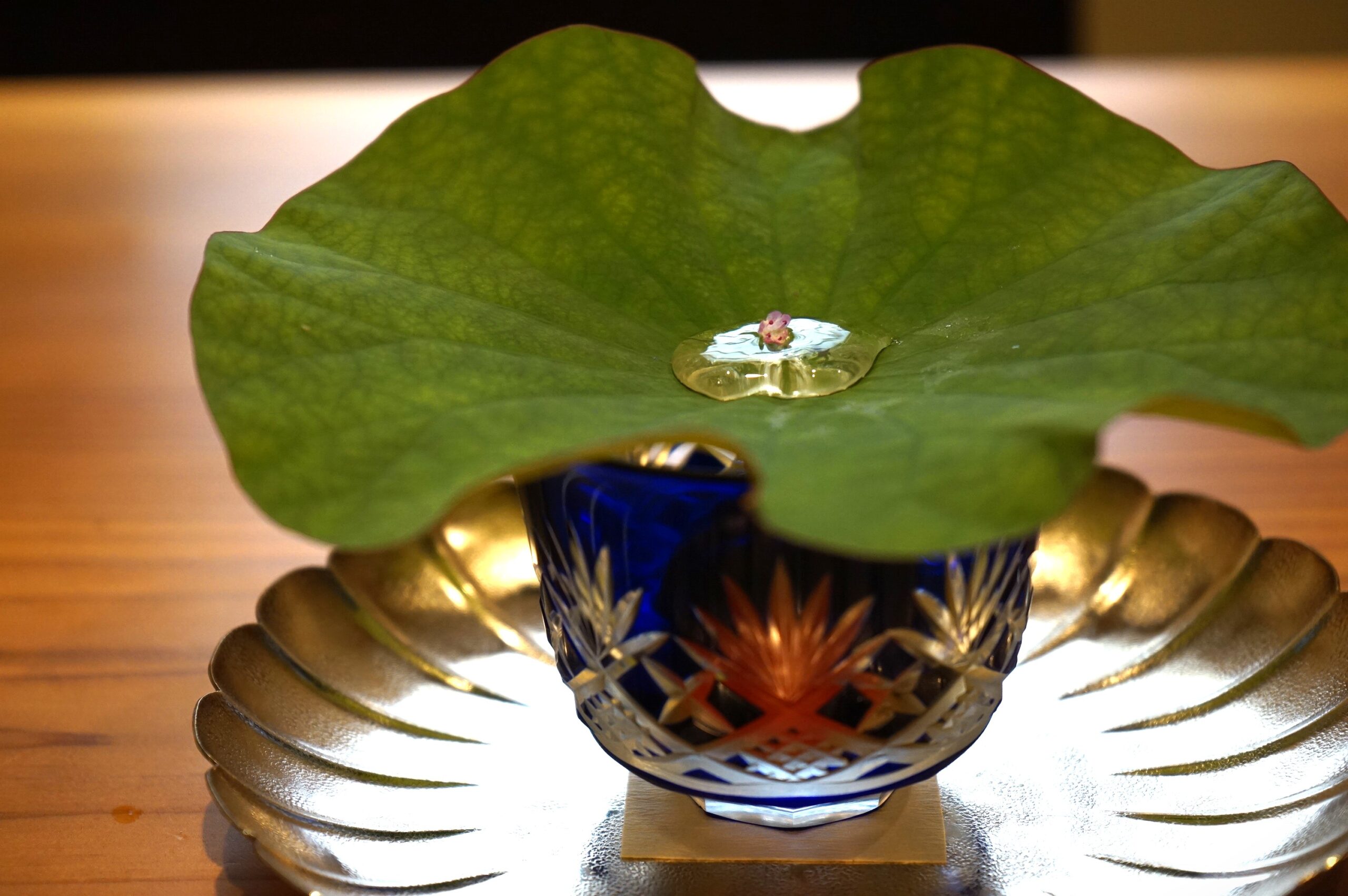
During this time, hydrangeas bloom vibrantly on street corners, and the gentle sound of raindrops falling on stone paths or moss-covered gardens offers a moment of serenity amidst the city’s hustle and bustle.
Early summer is also the season when plums ripen. The refreshing sourness of umeboshi (pickled plums) makes it a staple of Japanese cuisine, not only as a preserved food but also as a seasonal symbol—bringing both flavor and fragrance into daily life.
Surprisingly, this season sees fewer international visitors, making it something of a hidden gem. Even popular tourist spots tend to be less crowded, allowing for a more relaxed pace of travel. Flights and accommodations are often more affordable compared to peak periods, making it the perfect time for those seeking a quieter, more refined journey.
The sound of rain, the colors of blossoms, and the flavors of the season—
Japan’s early summer offers a quiet indulgence for all five senses.
Flavors of Summer
Japanese cuisine begins with the appreciation of the seasons.
In early summer, Japan offers a variety of ingredients that can only be enjoyed during this fleeting time. One such delicacy is ayu, or sweetfish. Found only in clear mountain streams, this river fish is also known as “fragrant fish.” When grilled over charcoal with a sprinkle of salt, it releases an aroma so vivid it evokes the very landscapes of rivers and forests.
Another seasonal highlight is hamo (pike conger), a summer staple especially beloved in Kyoto and the Kansai region. With its many tiny bones, hamo requires a special knife technique known as honegiri to prepare properly, making it a true test of a chef’s skill. Lightly blanched and served with plum sauce, it offers a delicate sweetness and a refreshingly cool taste.
And not to be forgotten is hamaguri (clam). Among them, those raised in Kuwana, Mie Prefecture, are particularly prized. Their peak season coincides with the rainy period of early summer, when their thick, tender flesh and briny, umami-rich juices make them one of the most luxurious tastes of the season.
In traditional Japanese cuisine, there is a concept known as hashiri (early season), shun (peak season), and nagori (lingering season). Chefs are trained to discern the precise stage of each ingredient as the seasons shift: Is today’s fish still in its early stage, or is it at its peak? Is this vegetable in its prime, or just holding on at the end of its season?
Even with the same fish or vegetable, the flavor, aroma, and texture subtly change depending on timing. Skilled chefs adjust heat and seasoning accordingly to draw out the best qualities of the ingredient in that moment. This sensitivity to seasonality is what gives Japanese cuisine its remarkable depth and elegance.
That’s why, if you’re visiting Japan, we encourage you to experience the taste of the season.
And the most refined and beautiful way to enjoy these fleeting seasonal treasures is through Kaiseki—the art of Japanese haute cuisine.
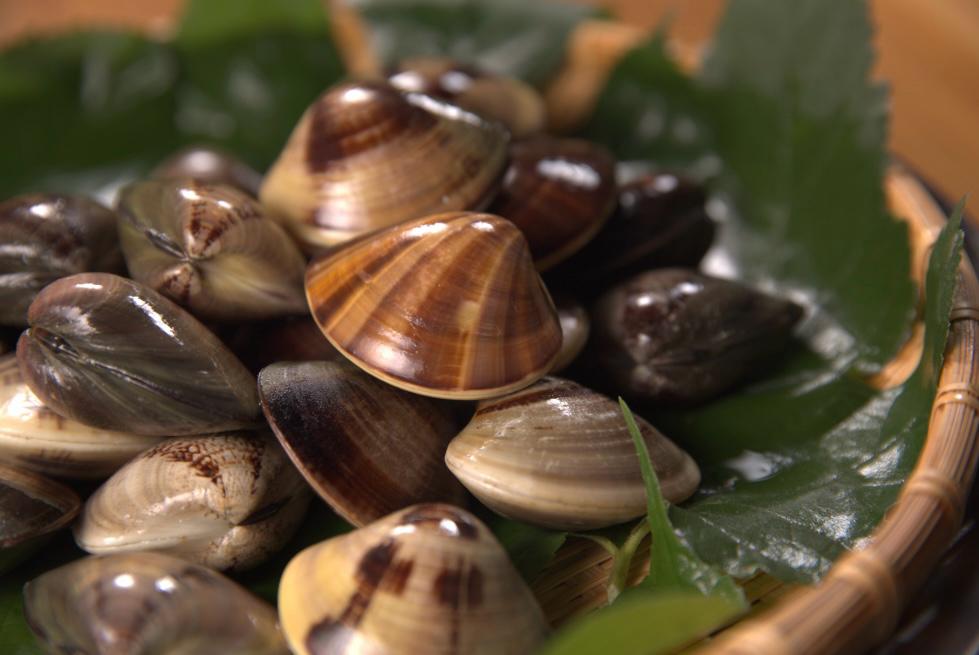
Why Try Kaiseki
If you’re visiting Japan, Kaiseki is not just a meal—it’s a cultural experience, and one that should not be missed.
Kaiseki originally developed as a way to host guests in the context of the Japanese tea ceremony. Over time, it evolved into a sophisticated culinary tradition where every element—from the seasonal ingredients and presentation to the tableware, ambience, and serving gestures—is in perfect harmony. Each dish is like a reflection of Japan’s refined sense of beauty, with even the space between the garnishes carrying meaning. Through Kaiseki, guests are invited to appreciate the seasons with all their senses, in a uniquely Japanese way.
Kaiseki is often described as a “five-sense dining experience.” You admire the aesthetics with your eyes, sense the seasons through aroma, and appreciate the delicacy of ingredients with your palate. The pacing of each dish and the server’s elegant movements also form part of the experience—offering a quiet, immersive moment that goes far beyond eating.
Another charm lies in its uniqueness. Even if you return to the same restaurant, the dishes will never be the same. With each change of season, the menu and presentation transform completely. This “once-in-a-lifetime” aspect of Kaiseki embodies the spirit of ichigo ichie—the Japanese philosophy of treasuring every encounter.
While Tokyo is home to many dining styles, Kaiseki remains one of the few ways to truly connect with the soul of Japanese cuisine.
For those seeking something deeper than sushi or ramen—a quieter, more introspective Japan—Kaiseki is a must-try cultural journey.
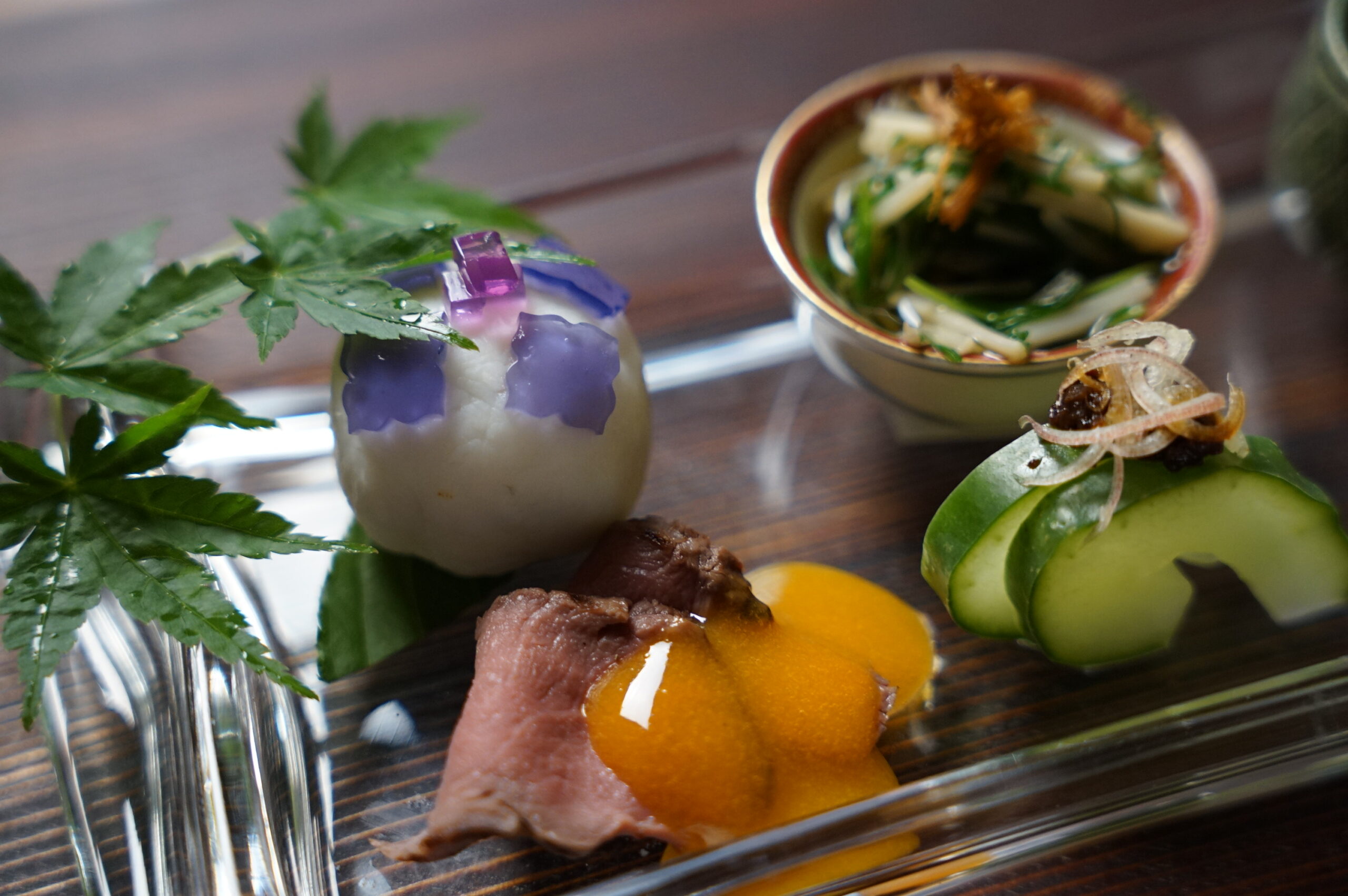
What Is Kaiseki?
Kaiseki is a one-of-a-kind dining experience that embodies the Japanese sense of aesthetics and spiritual culture.
Originally, Kaiseki referred to a simple meal served before a tea ceremony. The word literally means “a stone in the bosom,” originating from the practice of holding a warm stone against the body to ease hunger—symbolizing the host’s deep consideration for both the guest’s body and spirit.
Modern Kaiseki has evolved from this philosophy into a refined and artistic form of cuisine. It weaves together seasonal ingredients, delicate flavors drawn from dashi (Japanese broth), the sound and aroma of freshly prepared dishes, the texture and temperature of the serving ware, the colors of the setting, and the timing of each presentation—creating a cohesive story told through food.
Kaiseki is a culinary tradition experienced through all five senses.
You see the seasons reflected in the presentation, hear the gentle sound of a lacquered lid being lifted, smell the aroma of the broth, savor the delicate textures and flavors on the palate, and feel the serenity of the space around you. Each plate offers more than nourishment—it invites introspection and connection.

This is not simply a “luxury dinner.” It is, in many ways, a form of cultural entertainment for the intellectually curious—an experience that reveals new depth the more you learn about it. For travelers in Japan, enjoying Kaiseki can elevate a journey into something truly memorable.
That said, choosing the right restaurant is essential.
The most rewarding Kaiseki experiences are those where not only the food, but also its cultural background and seasonal meaning, are naturally and thoughtfully conveyed. Even first-time visitors can feel at ease in the hands of a host who brings Japan’s rich traditions to life—plate by plate.
Read more: What is Kaiseki cuisine?
Tokyo Cultural Dining
At Ise Sueyoshi, we offer authentic kaiseki cuisine crafted with some of Japan’s most prized seasonal ingredients. One example is the Ise-ebi (Japanese spiny lobster) from Mie Prefecture, known for its plump texture and natural sweetness. Delicately simmered abalone and premium wagyu beef that melts in your mouth have captivated gourmets from around the world. In winter, wild-caught fugu (blowfish)—rare even in Tokyo—makes an appearance.
Right in the heart of Tokyo, yet quietly detached from the city’s hustle and bustle—this is the world of Ise Sueyoshi.
Tucked away on a peaceful street in Nishi-Azabu, this intimate 10-seat kappo restaurant offers more than a meal—it offers an immersion into the beauty of Japan’s seasons and culture. As you settle into the warm wooden counter, you’ll find yourself embraced by an atmosphere where everything has been thoughtfully curated: the lighting and shadows, the colors of the tableware, and even the spacing between each dish. A quiet stillness fills the room, balanced with a gentle warmth that puts guests at ease.
This tranquil environment is upheld by a warm and welcoming team. At the heart is a chef who speaks fluent English, ensuring every guest feels naturally cared for. At Ise Sueyoshi, the spirit of Graceful Hospitality shines through—blending sincere friendliness with the poised elegance that defines Japanese service.
The location itself adds to the experience. Surrounded by museums and galleries, Nishi-Azabu is not a typical tourist district, but rather a serene “cultural zone” known to those who seek depth and calm. For travelers desiring a quiet moment amid their journey, it offers the perfect setting.
And above all, the food reflects the seasons with remarkable sensitivity. In early summer, you may encounter Shizuku, a dish that evokes the spirit of the rainy season; Hamo no Otoshi served with plum sauce; seasonal Hassun featuring ume (Japanese plum); and of course, the star of the season—Kuwana hamaguri clams. Each dish becomes a window into “this very moment in Japan.”
Kaiseki is not just a meal—
It is culture, alive within your journey.
Read More about Wagyubeef
Read More about fugu (pufferfish)
Read More about Ise Ebi Lobster
Read More about Tuna
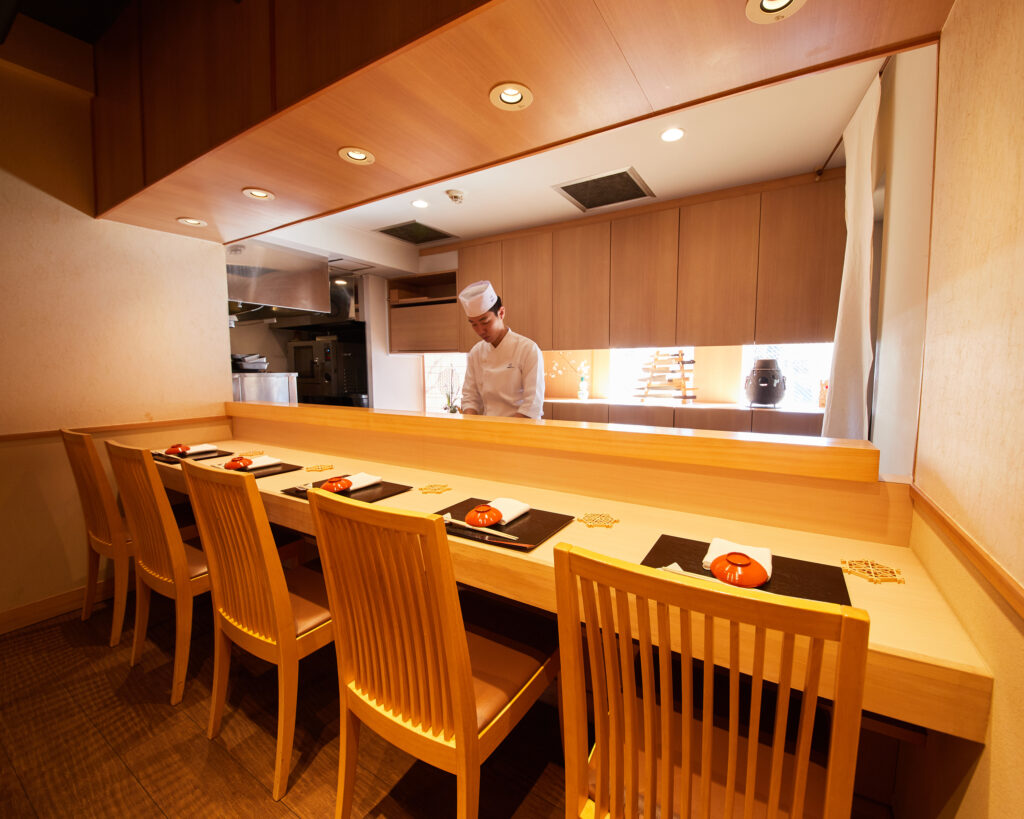
Secrets of Hamaguri
Have you ever tasted the world’s most delicious clam?
That title may very well belong to hamaguri, or Japanese hard clams, raised in Kuwana, Mie Prefecture—at their absolute peak in June.
Japan is home to several types of clams, including shijimi, asari, and hamaguri. Among them, Kuwana’s hamaguri stands out for its exceptional umami, aroma, and texture. The secret to its rich flavor lies in its place of origin.
The Akasuka fishing port in Kuwana sits at the estuary where three of Japan’s great rivers—the Kiso, Nagara, and Ibi—converge. Snowmelt from the mountains brings nutrient-rich water, feeding an abundance of plankton. Clams raised in this environment grow plump and thick, and when you bite into one, a flood of savory “clam essence” bursts forth.
At Ise Sueyoshi, we select only hamaguri of the perfect size—large enough to deliver a rich, satisfying bite, but small enough to enjoy in a single mouthful. If the clam is too big, the juices may spill as you chew; too small, and it lacks impact. We focus on that “just-right” size, with thin, delicate shells that hold the clam’s full flavor within.
Our top recommendation is the seasonal highlight: Hamaguri Shabu-Shabu, available only at the height of the rainy season. Each guest receives three clams, gently swirled in a special kelp broth and served the moment the shells open. Piping hot, they are best enjoyed in one satisfying bite—bursting with the pure umami of the sea.
It may just be the ultimate way to enjoy the world’s finest clam.
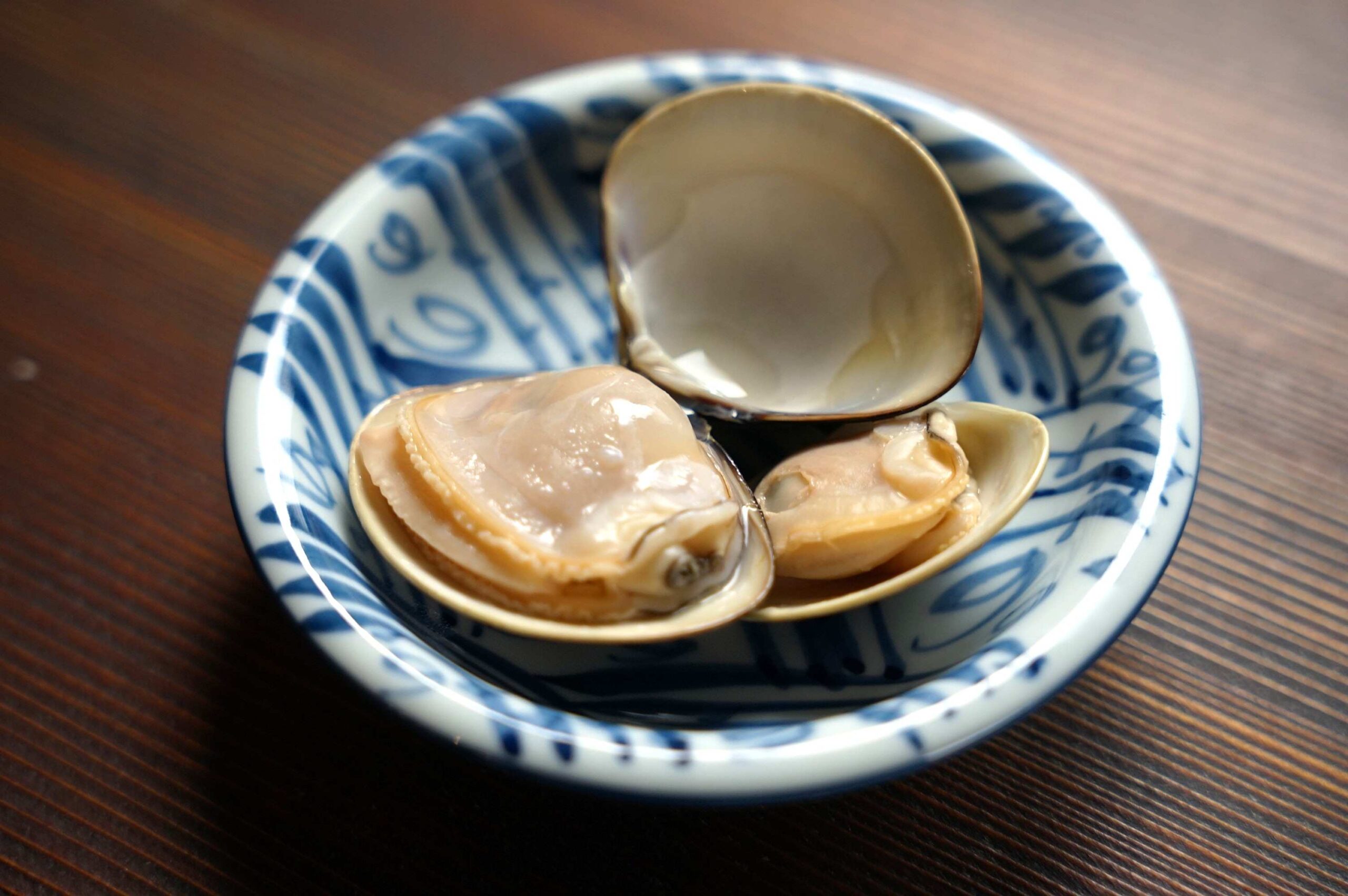
And to complete the experience, we serve nyumen—a warm noodle dish prepared using the remaining clam broth. The noodles are handmade hiyamugi from Ooyachi in Mie Prefecture, with a silky texture that perfectly captures every last drop of the clam’s essence. This final dish brings the meal to a gentle, unforgettable close.
This season. This place. This dish.
Everything comes together in a once-in-a-lifetime experience—awaiting you at Ise Sueyoshi.
Heart to Table
The true flavor of a dish is not born from technique or ingredients alone. Behind every bite flows an invisible current of heartfelt intention.
Chef Yuuki Tanaka, the head of Ise Sueyoshi, hails from Mie Prefecture. Many of the ingredients he uses—fish, vegetables, even sake—are sourced from his hometown. But this is not merely an expression of local pride. As he puts it, “There is always a reason behind something truly delicious.”
Take, for example, seafood raised in the richness of nature. Behind it lies the dedication and philosophy of the fishermen and farmers who nurture it. Chef Tanaka seeks to understand these producers’ passions and translate their stories into culinary form—so that each dish becomes a message, not just a meal.
One of the most important concepts guiding his philosophy is what he calls “Heart to Table.”
To share the spirit of the producers with his guests, he created a special book introducing the people behind each ingredient. Faces, places, values—he wanted these to be visible, tangible, and heartfelt.
What makes this even more meaningful is that feedback flows both ways. Guest impressions, moments of delight, and honest reactions are passed back to the producers. In this way, the cycle of joy, reflection, and refinement continues—making this not just a distribution of ingredients, but a circulation of human spirit.
Turning the pages of the Heart to Table Book while enjoying your meal allows you to truly feel that you are “receiving someone’s devotion.”
Behind every dish, there is a person.
That is why the Kaiseki experience at Ise Sueyoshi stays in your memory long after the final course.
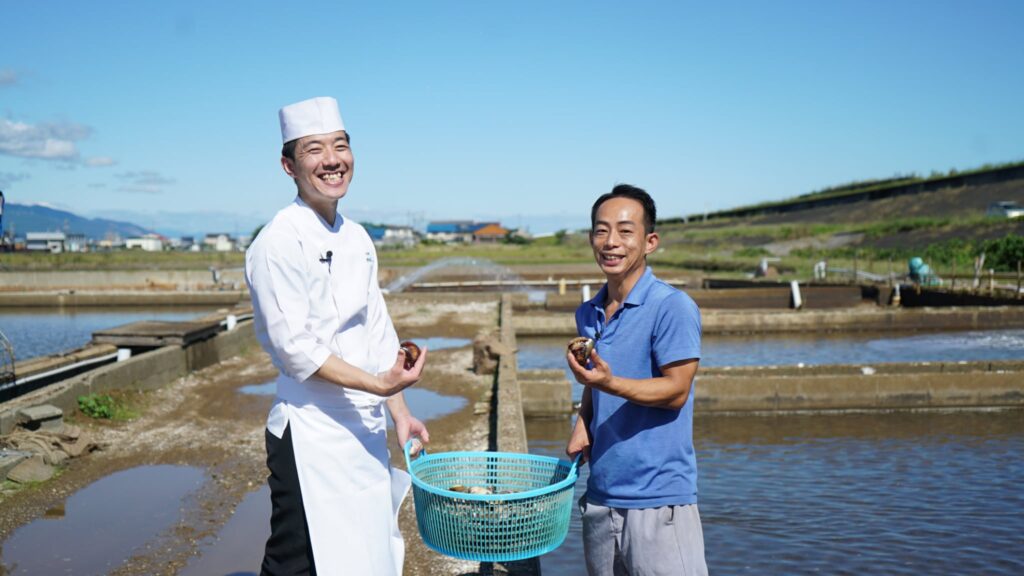
Read More about Chef Yuuki
The Story of Tokyo’s Best Chef, Yuuki Tanaka: Bringing the Blessings of His Hometown to the World
Graceful Hospitality
Many guests who visit Ise Sueyoshi say the same thing as they leave:
“It wasn’t just the food—my heart felt nourished too.”
One reason is the way hospitality is expressed here: with quiet dignity and refined subtlety. The restaurant features a private room and an intimate counter space, accommodating just ten guests in total. The atmosphere is serene, encouraging naturally gentle conversation—a perfect stage for deeper dialogue with the cuisine.
At Ise Sueyoshi, we cherish the concept of “a half-step ahead” hospitality. The staff appear precisely when needed—not too soon, not too late—maintaining a respectful, almost invisible presence. It’s a delicate sense of timing that ensures comfort without intrusion, making all the difference in a guest’s experience.
The chef and staff also speak English, so even first-time visitors to Japan can feel at ease. They explain the meaning behind each dish, the seasonality, and the thoughtful choice of tableware, allowing guests to engage with Japanese culture on a deeper level.
This level of care is only possible in such an intimate setting.
With just ten seats, every guest receives thoughtful, tailored attention—not merely polite service, but an experience that embodies the Japanese aesthetic of “ma”, the beauty of space and silence.
At Ise Sueyoshi, hospitality is not just service—
It is a quiet art form that leaves a lasting impression.
Inclusive Fine Dining
At Ise Sueyoshi, we take every measure to ensure that, regardless of religious, cultural, or health considerations, every guest can enjoy Kaiseki with complete peace of mind.
This dedication stems from our head chef, Yuuki Tanaka’s transformative experiences traveling the world. As a young chef, he journeyed through more than 15 countries with nothing but a backpack, undertaking unpaid internships at various restaurants and encountering a myriad of culinary traditions and people. In his travels, he noticed that many international guests were unfamiliar with Kaiseki, yet he was convinced that once experienced, its beauty would leave a lasting impression.
That is why Ise Sueyoshi is committed to making Kaiseki accessible to everyone. We offer flexible menu options tailored to meet diverse dietary needs—whether you require gluten-free, vegan, or vegetarian dishes, or if you have allergies to shellfish or dairy, or need meals that accommodate religious restrictions (such as no pork or halal-compliant options). Simply inform us in advance, and we will gladly adjust our offerings to suit your needs.
This personalized approach is possible because our restaurant is small, with only 10 seats, and operates by reservation only. We take the time to understand each guest’s background and preferences beforehand, carefully crafting a dish just for them—this is the essence of Ise Sueyoshi’s Kaiseki.
Kaiseki is, at its core, a cuisine of care.
It is our heartfelt wish to share that spirit with every guest, so that people from around the world may experience the exquisite hospitality of Japan.
For more about our vegan or vegetarian please visit this page.
For more about our gluten-free please visit this page.
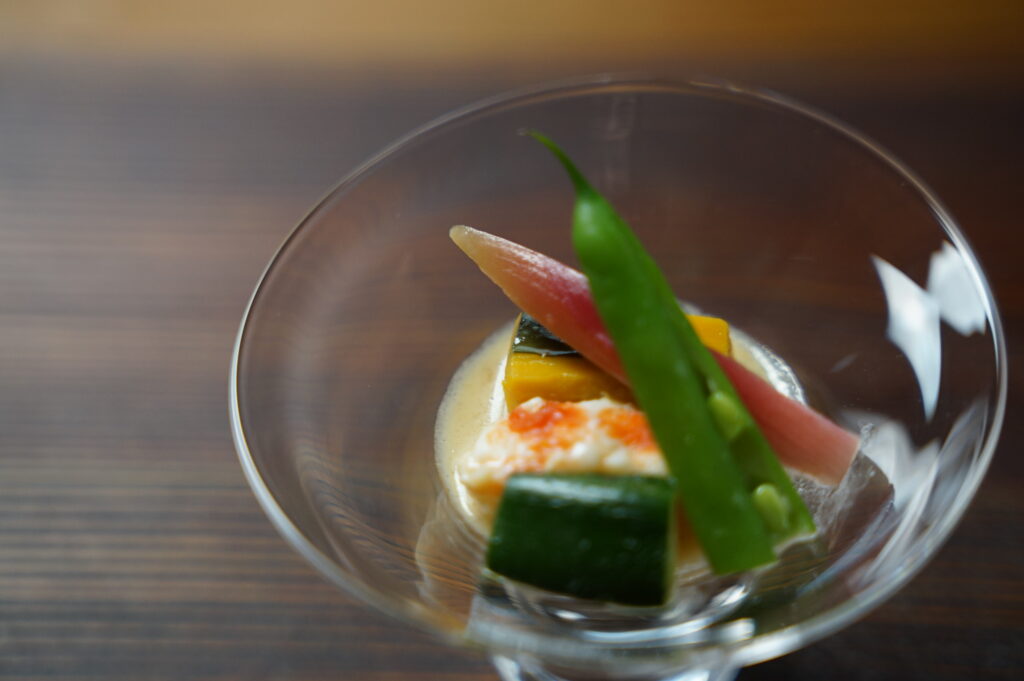
Artful Beverage Match
The power of a well-paired drink to elevate a meal runs deeper than most imagine.
At Ise Sueyoshi, we offer carefully curated sake pairings that harmonize with each season’s menu. Each pairing is thoughtfully composed to enhance the flavors of seasonal ingredients—through acidity, aroma, and finish. The result is an experience where two forms of artistry unfold in a single sip.
The sake we serve is also chosen from the chef’s home region of Mie Prefecture. Made with rice and water nurtured by the area’s mountains, rivers, and sea, these sake selections resonate naturally with the ingredients that also arrive fresh from Mie, creating a truly unified culinary experience.
At Ise Sueyoshi, beverages are not mere accompaniments—they are essential characters in the story of the meal. Introduced in rhythm with the Kaiseki course progression, they help shape the overall memory of the dining experience.
Many guests have said, “This final sip completed the taste of the evening.” We invite you to discover such moments for yourself.
For guests who prefer not to drink alcohol, we also offer an inspired non-alcoholic pairing. From sparkling green tea and house-made ginger ale, to premium kabusecha and juice made from Kumano mandarins—each beverage is crafted with the same attention to aroma, temperature, and balance, ensuring perfect harmony with the meal.
Read more about Sake Pairing:
Enhance Your Kaiseki Experience in Tokyo: Sake Pairing for Ultimate Satisfaction
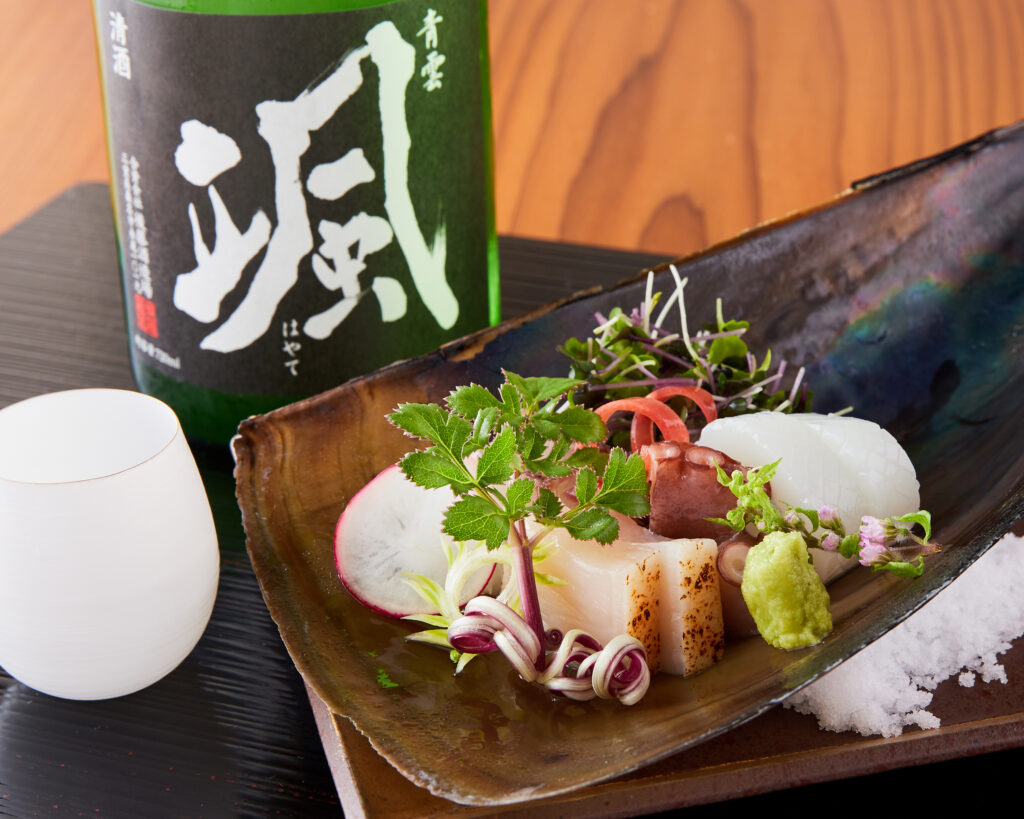
Perfect Trip Finale
Many international guests choose Ise Sueyoshi for their final evening in Japan. Why? Because it offers a truly special way to conclude a meaningful journey.
On the last night of a trip, we often seek a moment of quiet reflection—far from the crowds, away from the noise. In such moments, it is not the busy restaurants or tourist spots we desire, but rather a serene space where we can connect deeply with the spirit of Japan.
That is exactly what Ise Sueyoshi provides: a quiet, ten-seat kappo restaurant tucked away in a calm corner of Tokyo.
Here, you can surrender to the stillness and immerse yourself in the delicate progression of dishes, each prepared with precision right before your eyes. Conversation softens, and the entire space becomes part of your memory—etched into the final chapter of your journey.
On the short taxi ride back to your hotel in Roppongi or Omotesando, many guests find themselves saying, “This dinner completed my Japan experience.”
Ise Sueyoshi is also a popular destination for gift dinners—especially for honeymoons, birthdays, and anniversaries. It is often chosen as a meaningful way to mark special milestones with loved ones, creating memories that last long after the trip ends.
A trip begins with excitement.
It should end with calm and quiet satisfaction.
Through the timeless art of Kaiseki, Ise Sueyoshi offers not just a meal—but a beautiful finale to your time in Japan.
Many choose Ise Sueyoshi as a gift dinner for birthdays or honeymoons.
Learn more this article.
Our Guest’s Voice
An impeccable Kaiseki Experience
Jun 2023
What an impeccable #kaiseki experience – both culinary and culturally. We were only 4 people in the restaurant and Chef Yuuki Tanaka prepares everything from the seasonal ingredients from his hometown Ise. Our evenings theme was inspired from the “rain season” in Japan. We enjoy every bits of the food but the stand outs of the night are Fugu “puffer fish” and Ise Maguro sashimi, Matcha coated lobster, wagyu, milky clamps and matcha “soufflé” . If you are looking for special night out you won’t regret a second. Highly recommended !
We are proud to continue delivering an exceptional dining experience that earned us the Tripadvisor Travelers’ Choice Best of the Best 2024 award, ranking among the Best Restaurants in Tokyo. Our commitment to excellence in service and our dedication to offering the finest kaiseki dining experience in Tokyo remain unwavering. Discover more about our journey to becoming one of the best restaurants in the city[here].

Visit Ise Sueyoshi
Location: Conveniently located 12 minutes from Roppongi Station and 8 minutes from Hiroo Station.
Hours: Open 5:00 PM – 10:00 PM, reservations only. Closed on Sundays and Mondays.
Book Your Experience ☟
Reservation Information
In response to many requests from our guests, Ise Sueyoshi now accepts reservations up to 180 days in advance of your preferred dining date.
With only 10 seats available, we are committed to providing a smooth and personalized reservation experience.
To ensure you don’t miss the opportunity to celebrate your important anniversaries or special occasions with us, we highly recommend making your reservation as soon as your plans are set.
If you are planning a trip to Japan, we warmly invite you to include a special moment at Ise Sueyoshi in your itinerary.
Many of our guests also choose us for their final evening in Japan, as a beautiful and memorable way to conclude their journey.
Please note that our reservation policies may change without prior notice. For the latest updates, please refer to our reservation page.
Conclusion
At Ise Sueyoshi, we humbly invite you to experience a dining journey that caters to all dietary needs. Whether you’re vegan, halal, or have specific preferences, we are here to create a memorable and inclusive dining experience for you, especially for special occasions like a honeymoon.
Recommended Blog Posts
On our blog, we offer further insights into Tokyo’s rich food culture and the unique culinary experiences we provide at Ise Sueyoshi. Be sure to check out these recommended posts:
Where Fireworks Meet Tokyo Kaiseki: A Summer Night of Elegance |
Why You Must Try Kaiseki Cuisine in Tokyo: A Unique Experience of Culinary Art and Intellectual Delight |
@isesueyoshi
o 🏆 Awarded the prestigious Best Luxury Restaurant by TripAdvisor
o 🌍 Ranked 2nd worldwide, 1st in Japan, and 1st in Asia
o ⭐ Google rating of 4.9 (as of 2024)
o ✅ Vegan-friendly
o ✅ Halal selections
o ✅ Gluten-free options
o ✅ Vegetarian delights
o ✅ Pork-free choices
o ✅ Perfect for pescatarians
o 🌈 Welcoming and inclusive environment for LGBTQ guests
o 🚃 Just a 12-minute walk from Roppongi Station or 8-minutes from Hiroo Station
o ⏰ 5:00 PM – 10:00 PM (reservations-only)
o 📅 Closed on Sun and Mon
